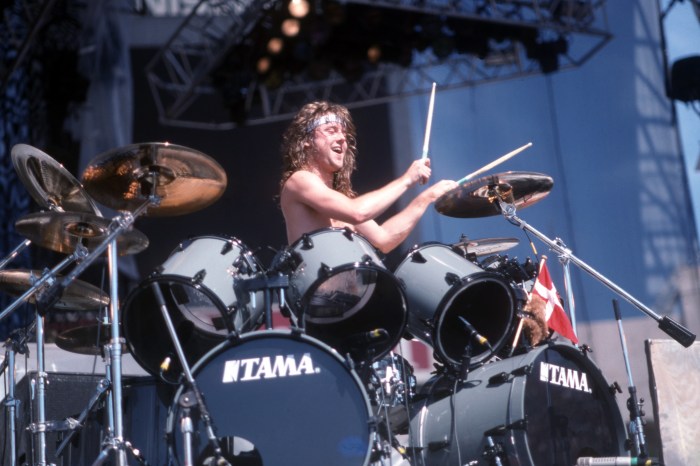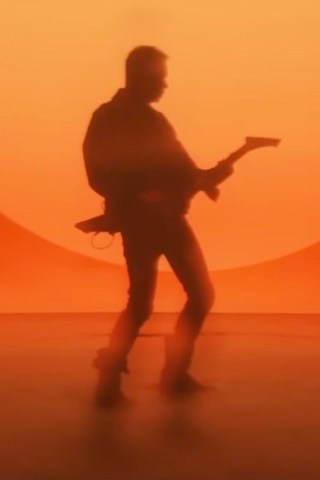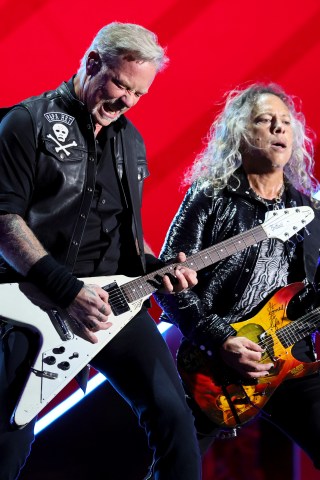Metallica Talks Million-Dollar Guitars, Making It Onto MTV, and How Opening for Ozzy Osbourne Got Them Out of Clubs and Into Arenas
Heavy metal legends join the Stern Show to promote their new album, “72 Seasons”
April 12, 2023Metallica returned to the Stern Show on Wednesday, sitting down with Howard for an epic interview and jam session spanning the length of the legendary heavy metal act’s career. Not only did frontman and rhythm guitarist James Hetfield, drummer Lars Ulrich, guitarist Kirk Hammett, and bassist Robert Trujillo open up about everything from the band’s early aversion toward MTV to how they perfected the riff for “Enter Sandman,” the freakishly talented foursome also put on a concert for Howard and his listeners which featured a hard-hitting Bob Seger cover, an acoustic rendition of a classic “…And Justice for All” track, and a single off their forthcoming album “72 Seasons.”
No More Thea-Tears
 Lars Ulrich performs during a 1986 concert
Photo: Getty Images
Lars Ulrich performs during a 1986 concert
Photo: Getty Images
Starting near the beginning, Metallica took Howard back to 1986. It was a game changing year for the band, which had just released its first gold album (“Master of Puppets”) and was setting out on the road with metal legend Ozzy Osbourne. “[Ozzy] was known to bring out bands that were on the verge of breaking. The time before he took us out he took Mötley Crüe out … It was our turn in ’86,” Lars said, crediting Ozzy and his wife Sharon Osbourne for being “kind enough to take us out and give us that shot.”
Metallica’s move from small theaters to massive arenas in the span of just a few years proved surreal. “The first show was in Wichita, Kansas — there we were in front of 15,000 people in the middle of America and we couldn’t believe it,” Lars continued. “We opened with ‘Battery’ and … ‘Master of Puppets.’ The first couple songs, [the crowd] was kind of looking up going, ‘What is this racket?’ And then 45 minutes later they were all moving their fists and getting into it.”
Hanging with Ozzy and the other A-list people in his orbit, Metallica knew they had finally made it. “We’d been playing in the minors for years, and now we were in the majors,” Lars concluded.
How ‘One’ Went to Number One on MTV
Metallica dropped four multi-platinum albums in the 1980s while cementing itself as one of the most popular heavy metal acts of all time, yet they somehow didn’t make it onto MTV until 1989 when the band released its epic music video for “One.”
“We wanted to have a video on there. They wouldn’t touch us,” James said of the network, which eventually changed its tune after Metallica’s massive fanbase demanded representation.
As Lars remembered it, the band took pride in not being mainstream. “There was definitely an element at that time of ‘We don’t belong, we don’t fit in, and we’re not part of that cool club,’” he called. “When you douse a little bit of cynicism on top of that, it’s like, ‘Fuck you — we don’t want to be on MTV.’”
All that changed when the band made a music video for their first Top 40 single, “One.”
“There was something dark about that song,” Lars said. “I think it was [late bassist] Cliff [Burton] and a few other people who kind of came up with this idea of doing a video in the spirit of that ‘Johnny Got His Gun’ movie and actually intercutting it with that footage.”
Ulrich vividly recalled how he felt when “One” premiered at number one. “It was one of those monumental days like, ‘Holy shit. This is real. There are thousands and thousands and thousands of people that want something different than the formulaic stuff they’re being fed,’” he told Howard.
The Origins of ‘Enter Sandman’
Metallica is one of the most successful rock acts of all time, so it’s no surprise Howard wanted to hear all about their songwriting process.
“It definitely starts with the riff,” James told him. “For me, as a vocalist, I try to insert where the guitar isn’t.”
To make his point, Hetfield started jamming out to “Enter Sandman,” the band’s first platinum single and the opening track of their critically and commercially adored self-titled album from 1991. “You simplify the riff, so the vocal has its place to jump around,” he said.
And just where did that now-iconic riff originate?
Kirk told Howard it came to him one night at 3 a.m. The riff was still in its infancy, he explained while playing the original version for Howard. It wouldn’t reach its final form until he took it to Lars, who suggested Kirk tweak the riff just a bit by repeating the first part three times and then adding a “tail.” “Three repeats and then a tail — then you have a workable riff,” Kirk said.
“Lars doesn’t know how to play guitar, and he will arrange stuff,” James said. “He’ll say, ‘Hey, can’t you do something in another key?’ … It’s like, ‘I wouldn’t do that. I can’t pick that,’ and it will be a challenge … So, there’s a lot of pushing of each other.”
“Thankfully, with this bunch of guys, when we go into a song writing situation we leave our egos outside,” Lars said. “There’s that freedom because there’s trust, and when there’s the trust there’s the love.”
Kirk’s Black Magic Guitar
These days, Metallica is so celebrated that even their musical instruments have become the stuff of legend. Robert Trujillo, for example, came to the Stern Show studio rocking a fretless bass guitar once owned by jazz icon Jaco Pastorious. “Each instrument has a personality, has a voice,” Rob told Howard. “It wants to speak.”
Kirk, meanwhile, won’t leave home without “Greeny,” a 1959 Les Paul Standard which Fleetwood Mac co-founder Peter Green and Thin Lizzy’s Gary Moore had previously owned. There’s a longstanding rumor Kirk paid $2 million for Greeny, but on Wednesday he set the record straight.
“I would never pay a couple million dollars,” Kirk told Howard, explaining the previous owner had given him a deal because he was in “financial straits.” “He brought it to my hotel, I plugged it in, and literally within 30 seconds, I said, ‘You’re not getting this guitar back,’” he recalled before waxing poetic about the guitar’s “super syrupy” tone and ability to sound just like a Fender Stratocaster.
Before Kirk started making magic with it, Greeny had been played by a litany of guitar gods — including Jimi Hendrix, Jeff Beck, and George Harrison — and was used to create Peter Green’s “Black Magic Woman,” among other songs.
It had also been test-driven by Kirk’s own frontman.
“I played it before [Kirk] did,” James told Howard. “The guy brought it backstage to show it to me, and I rejected it … I’m a real idiot.”
“And I played it before James,” Lars added with a laugh.
Regardless of who got there first, Kirk wasn’t letting Greeny go any time soon. “[We’re] inseparable now,” he said. “It’s literally 10 feet from me, no matter where I am.”
‘Turn the Page’
Metallica kicked off its three-song set with a high-voltage, saxophone-free rendition of Bob Seger’s classic road anthem “Turn the Page.”
“Other people’s material has always been a really big part of our DNA because we take our own songwriting so seriously … and sometimes you just want to fucking play,” Lars said before explaining why the Seger song appealed to him and the band so much they included it on their 1998 covers album, “Garage Inc.” “It’s an abstract take on fame, and a falling star, and what you do when your time in the spotlight has come and gone,” he continued.“
“The road life for sure can get to you, but it can also be of service — as it is for us — to go out and play and bring joy, man,” James added.
‘Blackened 2020’
The set continued with an acoustic version of “Blackened,” the blistering opener off Metallica’s 1988 album “…And Justice for All.”
“[The original] ‘Blackened’ was just … let’s play fast, and crazy, and get a speeding ticket from Slayer,” said James, who created the slowed-down version of the song during lockdown. “But [now] we get to rewrite these songs in a way … It’s fun to try.”
“We love taking some of the older songs and reinterpreting them acoustically,” Lars added. “You can take a great song and you can park it in any genre, [but] the meat and potatoes of it still remains the same.”
“I couldn’t breathe during that,” co-host Robin Quivers said after “Blackened” had finished. “It was so beautiful.”
‘Lux Æterna’
Metallica concluded its live in-studio set with an exhilarating performance of “Lux Æterna,” the lead single off their new album, “72 Seasons.” The album’s title represents the first 18 years of one’s life — when one’s character, core beliefs, and sense of self are developed — but as James explained it, he had originally hoped to name the whole thing “Lux Æterna,” which is Latin for “eternal light.”
“We’ve been talking about darkness forever. We know it well and it still lives there. We’ve embraced it and it’s still a part of us … but there is hope,” James concluded. “It’s not all just doom and gloom.”
Give the Drummer Some
When Howard noted he was impressed with Lars’ double bass drumming on songs like “One,” the drummer proceeded to give an impromptu clinic on technique. “I stomp on the kick drum,” he explained of his approach. “I play kind of with the front of my foot … it comes from the athletic side of my family, just growing up around tennis and everybody in my family were tennis players, were soccer players.”
After decades pounding and stomping away behind the kit, Ulrich insists that, while drumming can be a challenge on his shoulders and elbows, his feet have not failed him. “The feet are not so bad,” he noted. “If I’m playing super-fast, up in that register and playing those fast kick drum patters and stuff like that, that actually flows fairly easy for me.”
The rocker did say certain songs are more challenging than others. “The ones that are the hardest are the ones where you have to play with your mind, where you have to keep thinking about the next parts,” he said, citing examples like “Eye of the Beholder” and “The Shortest Straw.” “Some of those songs we’ve kind of edited along the way to make them a little less heady and a little more physical and try to just continue to have them, you know, evolve so they fit our playing style more.”
Metallica’s “72 Seasons” arrives Friday, April 14.






















